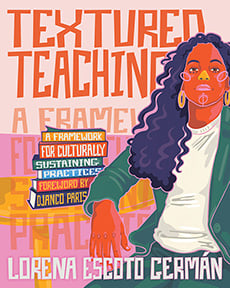
Editor's Note: This is part one of the Bias in Teaching series adapted from Textured Teaching by Lorena Germán.
Racialized Imaginations
In her riveting book Playing in the Dark (1992), Toni Morrison outlines the way the literary imagination is clouded by the presence of race and racism. In short, she introduces the idea of an “Africanist presence” that hovers over the writers of American books and is embedded, like a shadow, in the plot and all other literary traits. She argues that there is no way that Blackness is omitted from even the Whitest of books, since it is precisely the absence and distance from that Blackness that creates the Whiteness in the first place. I know: mind blown! And so, in the same way, it is important for us to reckon with the truth that the books we all read in high school, the books all considered canonical and “classical,” are saturated with implicit or explicit racism. All of these books are affected by bias. The perception that American literature is unshaped by more than 400 years of Africans on this soil is, in and of itself, racist. Sustaining this myth allows racism to go unquestioned and uninterrupted and maintains the status quo. This idea that literature is “universal” or free from race and neutral is akin to colorblindness and uplifts the status quo, which we know is oppressive. How could such a presence not impact all aspects of life and culture? Of course it has. In her book, The Dark Fantastic (2019), Ebony Elizabeth Thomas echoes this by saying:
Although I grew up in the first generation after the classical phase of the Civil Rights Movement, my literate imagination was quite segregated. Books and movies about children and teens who looked like me were read and viewed out of duty, in order to learn about the past. Books and movies that showcased the pleasures of dreaming, imagination, and escape were stories about people who did not look like me. And yet I was most drawn to those magical stories, for I longed to dream. (17)
We have to interrogate our imaginations and dig deep to challenge these ideas we’ve learned.
One way to examine the imagination is to study the silence and omissions in stories. What voices are excluded from the literary canon? What stories are missing from our collective cultural knowledge? “[I]n matters of race, silence and evasion have historically ruled literary discourse” (Morrison 1992, 9). The silences have allowed a performative universality to be applied to literature that is insidious. It is toxic. It leads us all to believe that people of color don’t matter because we don’t exist in the mind or imagination of the authors of our books and textbooks. That is a myth, because of course we do. To exclude us from curriculum is to murder us—to operate as if we don’t exist, to remove us from existence in people’s minds. In fact, race, the child of racism (as it’s referred to by Ta-Nehisi Coates [2015]), was dreamed up by Johann Blumenbach, who decided that Caucasians were in “first place” above other people groups. How we existed in his imagination became our lived reality. It became scientific truth, led to policies, and is life today in the twenty-first century. These subconscious racist imaginations are what lead an officer, an otherwise kind person, to pull the trigger and kill an innocent Black man. These subconscious racist imaginations are what lead people to follow innocent patrons of color in stores due to fears of theft or wrongdoing. These subconscious racist imaginations are what lead editors to think that a Black woman’s story won’t sell, but accept the same story from a White author. It’s these imaginations that inform the books teachers select. And these books build those imaginations. It’s a vicious cycle.
Interrogate the Imagination
Consider engaging with students in an activity around interrogating the imagination. In partners, students respond to a series of reflection prompts:
- Create a list of the voices that are overrepresented in this book.
- Create a list of the cultural points of view overrepresented in this book.
- Create a list of the missing voices in this book.
- Create a list of the missing cultural points of view in this book.
- What social issue or problem is this book speaking to? Is it doing so intentionally?
- What social issue might this book be unintentionally highlighting?
When the partners return to the whole-class group, it is interesting to see what the various partners identified. That diversity of responses alone might be enough to help students see how each of our personal biases informs our lens and allows us to “see” texts differently.
***
With Culturally Sustaining Practice as its foundation, Textured Teaching helps secondary teachers in any school setting stop wondering and guessing how to implement teaching and learning that leads to social justice. Lorena Germán shares her framework for creating a classroom environment that is highly rigorous and engaging, and that reflects the core traits of Textured Teaching: student-driven, community centered, interdisciplinary, experiential, and flexible. Throughout the book, she shares lesson design strategies that build traditional literacy skills while supporting students in developing their social justice skills at the same time. The actionable strategies used to bring Textured Teaching values to life illuminate what is possible when we welcome all types of texts, all types of voices, and all forms of expression into the classroom.
Related Reading

The following is excerpted from Textured Teaching: A Framework for Culturally Sustaining Practices by Lorena Escoto Germán.


